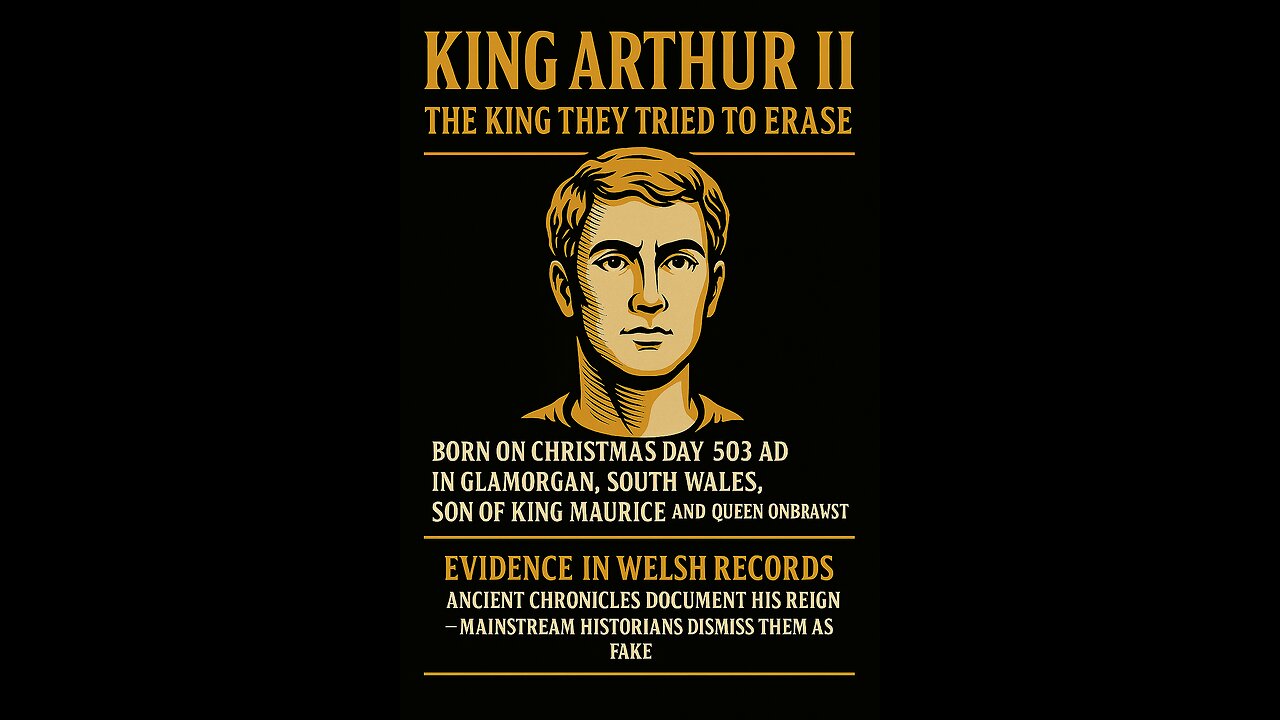Premium Only Content

King Arthur II - The King They Tried to Erase.
King Arthur II: The Overlooked King of Britain.
King Arthur II was not the stuff of fairy-tale invention, nor the conjured hero of medieval romance. He was a flesh-and-blood monarch, born on Christmas Day, 503 AD, in Glamorgan, South Wales. His father, King Maurice, and mother, Queen Onbrawst, reigned in a lineage of power that traced directly to his grandfather, King Theoderic. Unlike the mythical Arthur of chivalric lore, King Arthur II did not have to prove his right to rule by pulling a sword from a stone — he was born to be king, heir to a dynastic legacy going back to Maximus Magnus, Constantine the Great and all the way back to King Brutus.
Separating Man from Myth.
The King Arthur most people know is a patchwork of legend — knights in shining armour, magical swords, and the counsel of wizards. But the historical King Arthur II lived centuries before the embellishments of Geoffrey of Monmouth and Thomas Malory transformed him into a medieval romance hero. His story is rooted in a turbulent post-Roman Britain, a fractured land where warlords fought for dominance and survival.
Evidence in the Welsh Records.
The most compelling evidence for King Arthur II’s existence comes from ancient Welsh records — meticulously kept chronicles that detail rulers, battles, and events of the era. These records, though dismissed by many established historians as unreliable or fabricated, offer precise genealogies and timelines that match archaeological and historical markers. Their dismissal often says more about the stubbornness of academic orthodoxy than the credibility of the records themselves.
The Warrior King.
Arthur II was a formidable military leader, winning twelve great battles that secured his place as Britain’s protector. Among these was the legendary Battle of Badon, a decisive victory that stemmed Saxon incursions and preserved native British rule for generations. These were not isolated skirmishes, but a sustained military campaign requiring strategy, leadership, and the loyalty of his warriors.
The Suppression of History.
Despite the richness of the historical evidence, King Arthur II’s story has been systematically pushed to the fringes of history. Researchers such as Alan Wilson, Baram Blackett and Ross Broadstock have spent decades piecing together the truth from ancient manuscripts, archaeological sites, and cross-referenced genealogies — only to be met with hostility, ridicule, and academic stonewalling.
Why? Because the truth about Arthur II challenges the established historical narrative. It disrupts the tidy version of British history taught in schools, where Saxon dominance is inevitable and native British kings vanish into obscurity after Rome’s fall. To acknowledge Arthur II’s reign is to admit that post-Roman Britain was far more organised, resilient, and resistant than many historians care to admit.
Wilson, Blackett and Blackett argued that political and religious forces in the centuries following Arthur II’s death had strong reasons to erase or distort his legacy — consolidating power under new rulers, promoting alternative myths, and ensuring the true lineage of Britain’s kings faded from collective memory. By turning Arthur into a quasi-mythical figure, they could control his image while erasing the inconvenient truths of his real reign.
Why Does His Story Matters?
The suppression of King Arthur II’s true history robs Britain of one of its greatest national figures. By conflating the real man with the myths that followed, historians have buried a legacy of leadership and resilience under layers of medieval fantasy. Understanding the life of King Arthur II not only rewrites the history of Britain’s Dark Ages — it challenges us to look beyond convenient narratives and seek truth in the records our ancestors left behind.
King Arthur II was not a fairy-tale king. He was a ruler of flesh, blood, and iron will, a leader whose victories shaped the destiny of Britain. It’s time his true story was told.
-
 LIVE
LIVE
The Charlie Kirk Show
1 hour agoAllie Beth Stuckey on the Charlie Kirk Revival | Kirk Cameron | 9.23.2025
8,564 watching -
 1:07:21
1:07:21
Timcast
1 hour agoTrump Declares Antifa TERRORISTS, The Ultimate Test For The U.S. And Threat Of Civil War
67.2K52 -
 LIVE
LIVE
Barry Cunningham
35 minutes agoPRESIDENT TRUMP HOLDS MEETINGS AT THE UNITED NATIONS!
719 watching -

MattMorseTV
4 hours ago $4.88 earned🔴Trump's United Nations BOMBSHELL.🔴
40.8K15 -
 LIVE
LIVE
Rebel News
45 minutes agoRebels on the ground for ostrich cull, New hate crime bill, Ford on homeless crisis | Rebel Roundup
299 watching -
 4:23
4:23
Michael Heaver
8 hours agoItaly Suffers Extreme BLOCKADE
122 -
 1:59:09
1:59:09
Steven Crowder
4 hours agoWe're Done Apologizing: Trump Torches Indian H-1B Visas & The United Nations
295K258 -
 43:39
43:39
The Rubin Report
2 hours agoHost Goes Quiet as Press Sec Destroys Jimmy Kimmel Narrative w/ Facts in Under 1 Minute
20.7K15 -
 LIVE
LIVE
Side Scrollers Podcast
2 hours agoKimmel RETURNS + Twitch University + More! | Side Scrollers
382 watching -
 LIVE
LIVE
The Mel K Show
2 hours agoMORNINGS WITH MEL K Defining Liberty: Where the Constitution Stands in a Surveillance State 9-23-25
797 watching